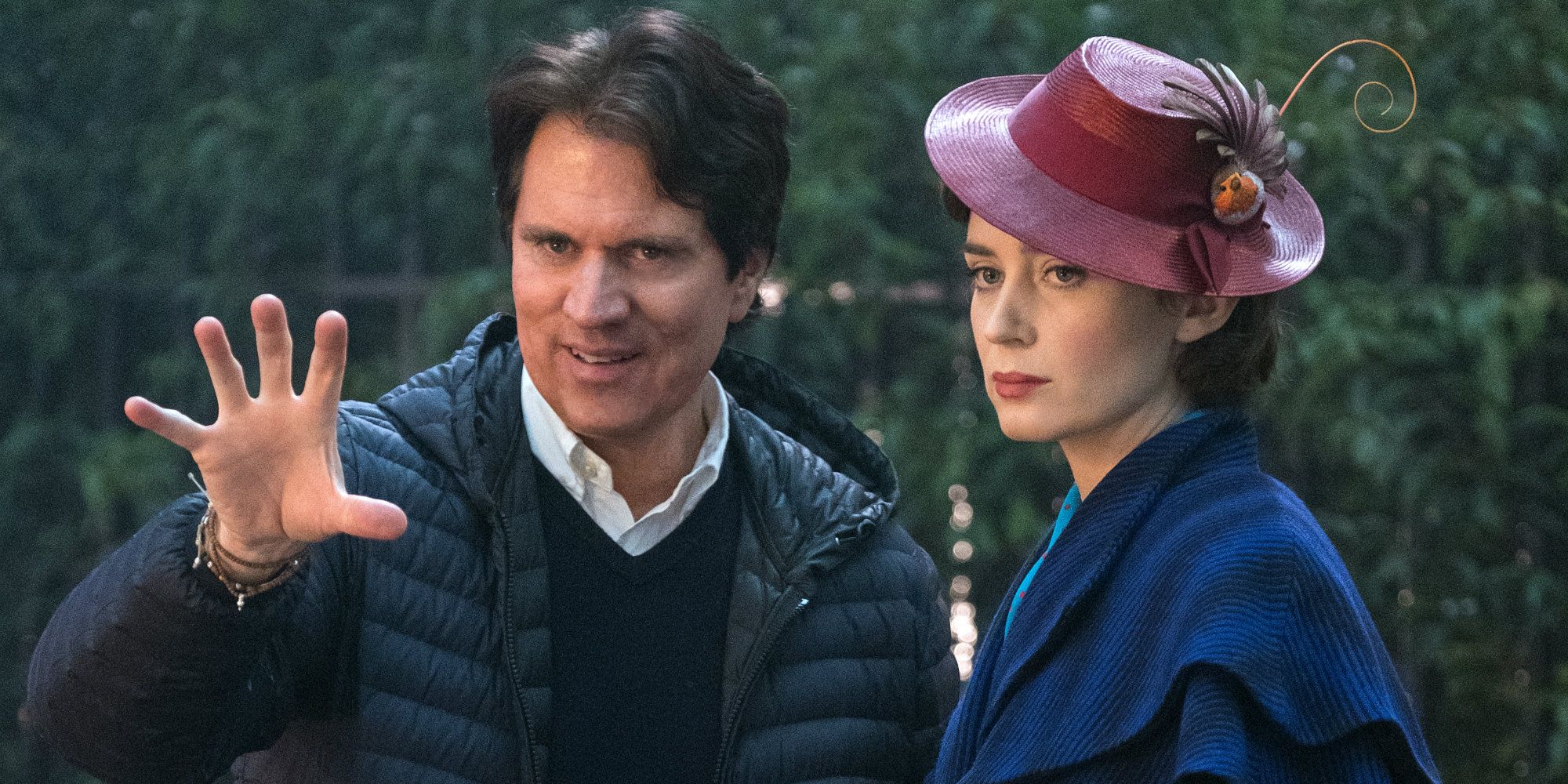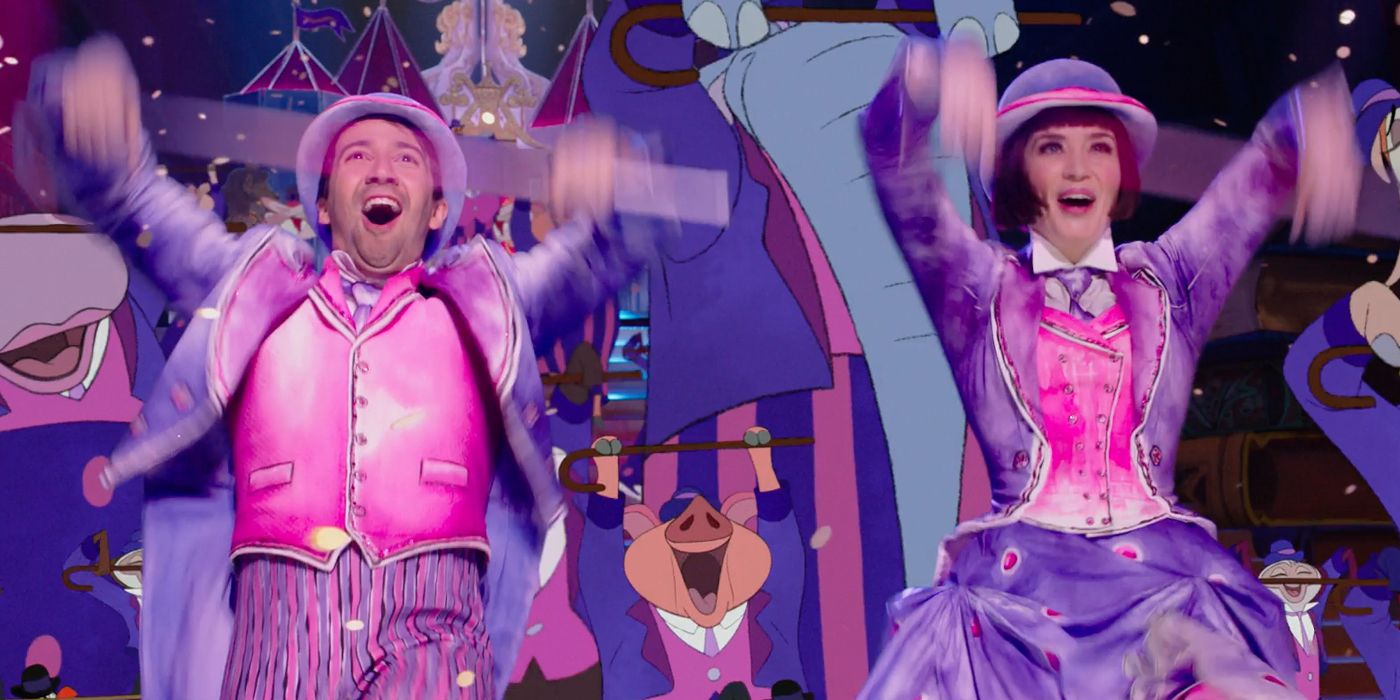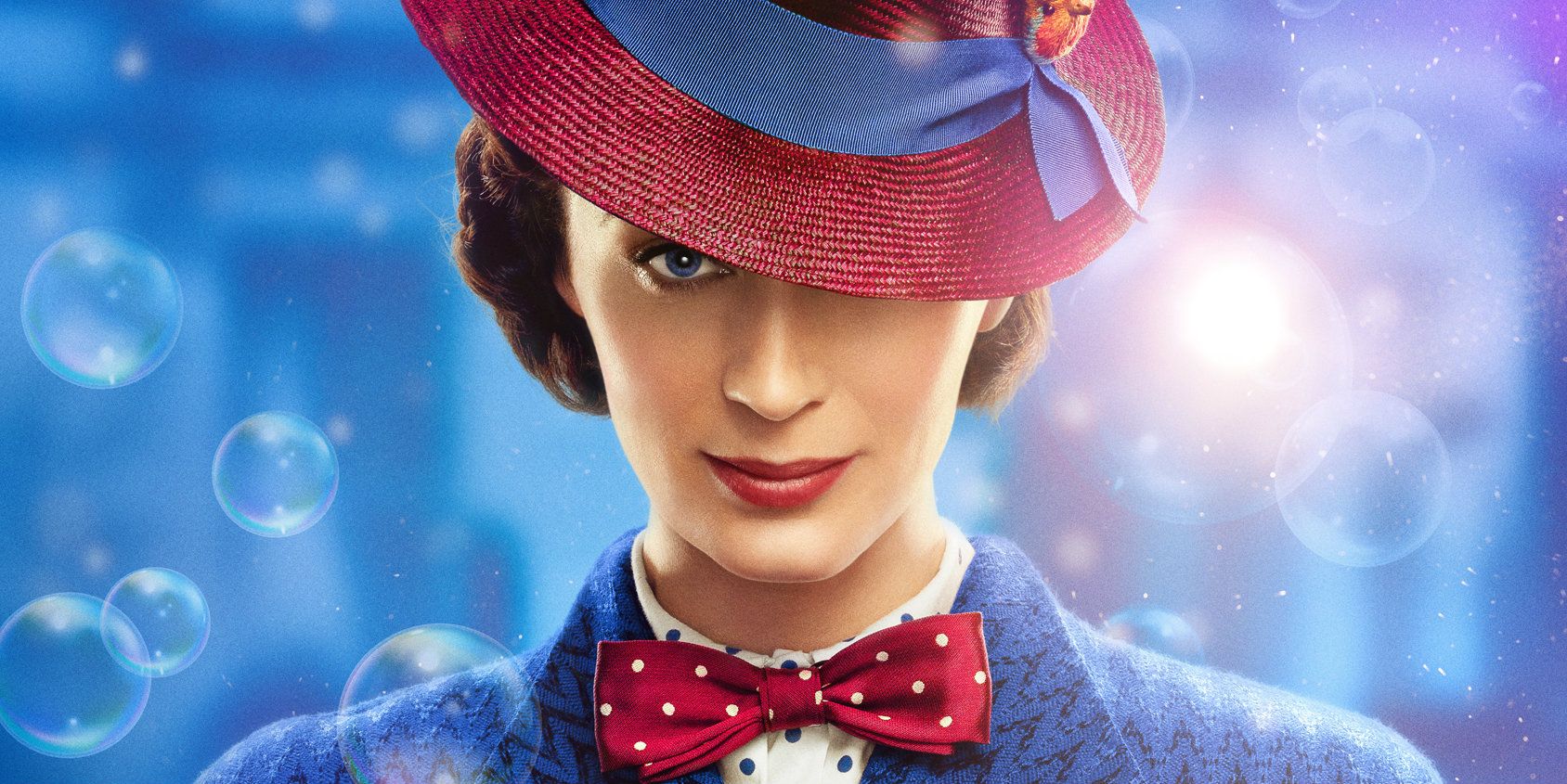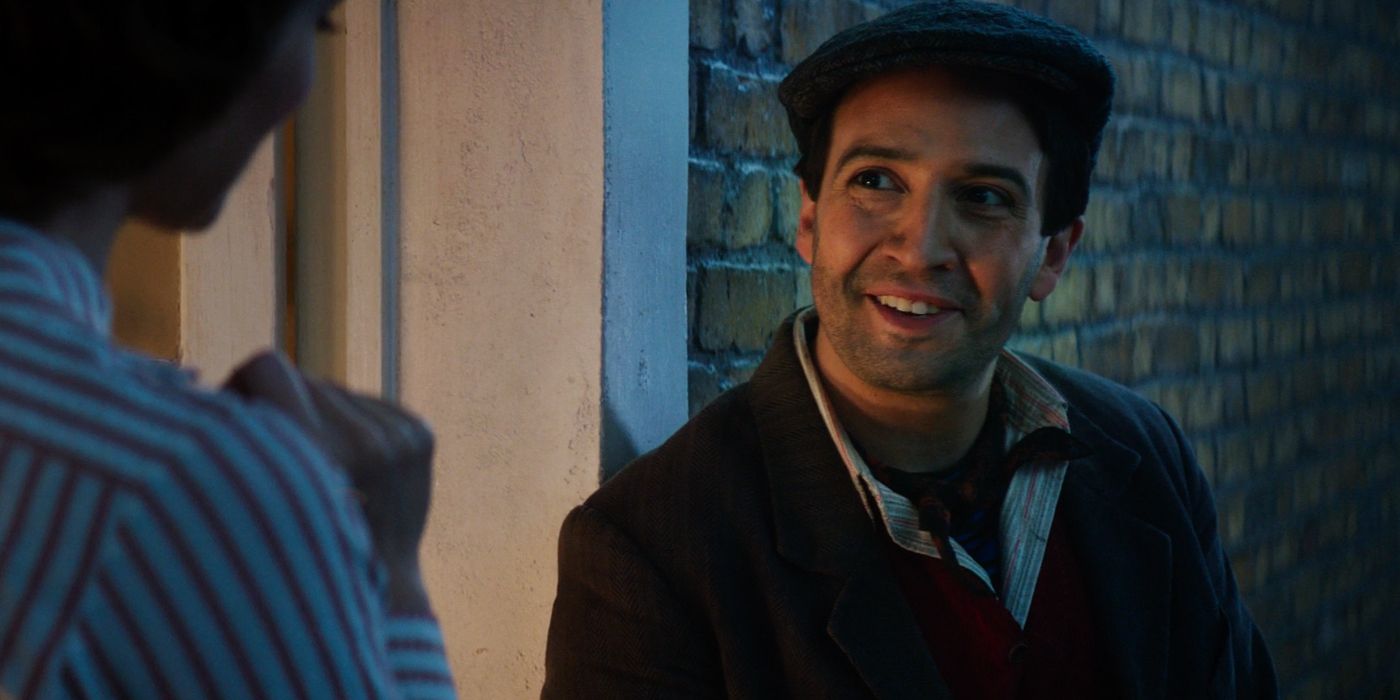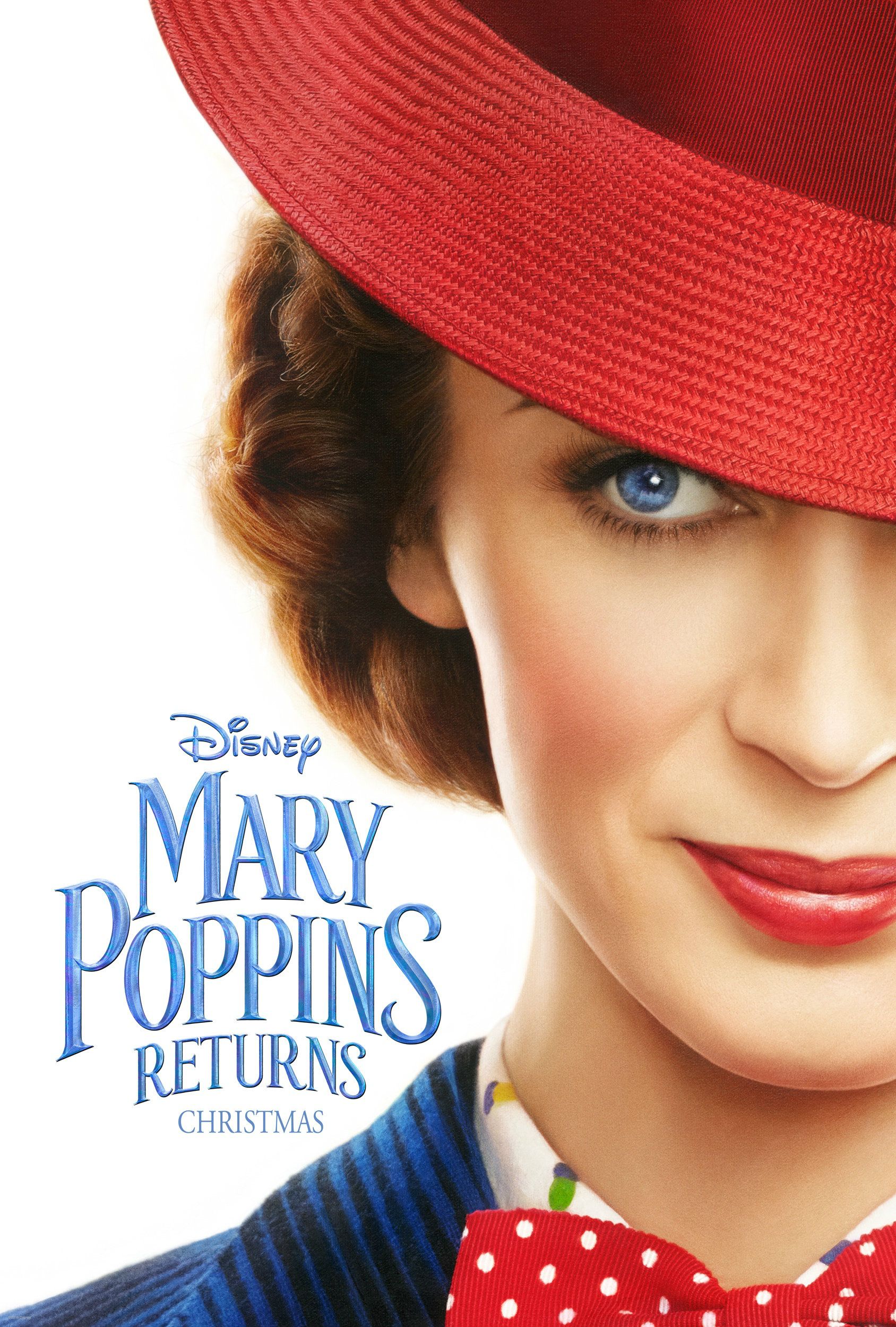The prospect of a Mary Poppins sequel was a daunting one for all involved, but none less than Mary Poppins Returns director Rob Mashall. Emily Blunt had to step into the shoes of Julie Andrews and Lin Manuel Miranda needed to evoke Dick van Dyke while correcting that accent, but Marshall needed to bring the real Disney magic. The director of many a screen musical (and winning Best Picture with Chicago), this is nevertheless his biggest challenge.
It's a challenge he's more than readily taken on and, if early buzz is to be believed, one that Marshall's more than handled. Mary Poppins Returns is one of the most anticipated films still to come in 2018, and the biggest release with genuine Oscar hopes - and so much of that has to fall on the director.
Related: Mary Poppins Returns Set Visit: Lin-Manuel Miranda Interview
When Screen Rant visited the Shepperton Studios set of Mary Poppins Returns last year, we got to witness Marshall directing a key song-and-dance number featuring Blunt, Miranda and a mass of extras. He also provided us with answers to some of the biggest questions about the film.
How relevant do you think Mary Poppins is as a character, thinking about both the movie in the ‘60s and the books in the ‘30s, how relevant is she now?
It’s funny because PL Travers started writing in 1934 in the middle of the depression, and this whole sense of what she wrote about, a magical person coming and trying to bring wonder and joy into a family and bring a child-like sensibility to adults. She wrote eight books and throughout those eight books you see that theme, this sense that adults forget the joys of childhood. I know she was considered – I didn't know her obviously – a tough lady, but I think she really understood child-like wonder.
So when Disney came to us with this, it was right at a point in the world where John DeLuca and myself, my partner and I, were so desperate to do it for that reason; in order to balance out the world in which we live in now, and we have spent three years working on this film. To live in a world that has hope and escape and fantasy and truth and reality and emotion and all those other things, feels so important right now. In fact, it has become more important each day in this world. And when I approached people like Meryl Streep or Colin Firth to play a role, they jumped on it quickly for the same reasons. I remember Meryl Streep saying to me immediately, she said, I want to be part of bringing this message to the world now. She said, This, to me, is a gift to the world now. And so it was immediately apparent to me that this was the story to tell today, even though the series of books began in 1934, the film is from 1964 so it's from 54 years ago.
The first film means a lot to a lot of people, especially to someone around my age, because I saw it when I was four or five years old, and it opened my mind to so many things. So it has been really beautiful to be part of that message for all this time.
Is it the other side of the coin when you watched the movie at five, and this is a sequel, not a remake, the fact you loved the movie so much, was it more tricky?
Well, of course, it's daunting. You are following a classic film. But what I was unaware of, and became aware of, is that PL Travers wrote eight books throughout the course of her life, so there was so much material. The second book was called Mary Poppins Comes Back, and then there was one called Mary Poppins Opens the Door and Mary Poppins in the Park, there were all these books that she wrote, so there was already all this material that existed. And I know that in the ‘80s for instance, when Jeffrey Katzenberg was at Disney, I know they explored the possibility of doing a sequel, and why wouldn't you, especially with all of this material? But, as we famously know, PL Travers was very protective of the material so it was always very difficult to try and make happen. And having seen the first film, I would never consider a remake… you don’t touch that film.
So we had to look for another way to tell the story. So in addition to working with all the new material, the new adventures from PL Travers, we actually set the film in the era when the books were originally written, which is in the ‘30s, London’s depression era, which coincidentally is 24 years later than when the first film was set, 1910, which then made Jane and Michael Banks older, so it was this new generation.
There was another story to tell in a different era with the same character, with an iconic character. We, at first, struggled with it, because you're sort of like, how do you do this? How do you enter this? But then you look at iconic characters like James Bond, who have been reimagined so many times over the years with the different novels and even a Star Wars film that has so many layers and so many characters, how they began and where they are now, all the wonderful, great stories that have had sequels or prequels or whatever, and it just felt like we had to do it in a respectful way and pay homage to the first film, and that's been our focus the whole time.
You mention the traditional animation sequences. Why did you want to bring back the kind of animation you almost never see anymore?
Yes, well I feel there are things in the DNA of it, you know, that I thought, what would I want to say, I mean honestly, as a huge fan of the first film, what would I want to see? I’d be so disappointed if they didn't disappear into a world of animation, because if you go back to the PL Travers’ books, in the first one they go into a chalk painting… in Mary Poppins Comes Back they go into a Royal Doulton bowl. They disappear into it, so it just made sense to do because it felt like it was in the DNA of that world. And we've obviously come a long way in terms of animation. Most of it is computer-generated now, but what's lost with that is that sense of artistry, this beautiful and extraordinary work.
I really thought it would almost feel new again because it hasn’t been done for so long, and what was really quite extraordinary is that many animators came out of retirement. Also very interesting, we had a lot of animators in their 20s who were much more interested in doing the old school animation as opposed to the new computer-generated work, and it was fascinating to see them at work. And now we can move the camera through a two-dimensional painting in a more modern way so that you're actually inside it. If Disney would have had this technology back then, I’m sure he would have used it, too. So when you see the film, you are in this 2D hand-painted world but in a three-dimensional way. It's why our post-production has been longer than normal. I mean, we have all been in post-production for a year because of that, but it is live action and animation so there's this wonderful interaction between the two, and I believe everyone feels it was worth it. Everyone agreed it felt fresh again, when you see them speaking to these animated characters that are drawn that way and you feel that artistry, you feel a sense of nostalgia. But we're picking up the story 24 years later and it's a completely new story with completely original, all-new music.
And that's something, by the way, that I've always wanted to do. The musicals that I have done on film have all been Broadway transfers: Chicago is a Broadway show, Nine was a Broadway show, Into the Woods was a Broadway show, where you had the challenge of opening it up to film. I've always, always, always wanted to do an original musical for film, like from the golden age of MGM under Arthur Freed’s unit, when they would, say, create a movie for Fred Astaire. So they would do The Bandwagon for Fred Astaire or they would do Singing in the Rain for Gene Kelly or they would do Meet me in St. Louis or Easter Parade for Judy Garland. They would write musicals for the talent and create them from scratch, and here I was getting to do that, which has always been a dream of mine because when you're working on something from the stage, you're always having to take it off the stage, take it out of the proscenium, and open it up. This was like, wow, now I can actually create it for film, and that was just joyous for me, really, a dream come true.
Had you crossed paths with the composers in the past?
Yes, I have known Marc Shaiman and Scott Wittman since I first came to New York… in fact, I worked with them on Hairspray. I was the director on the film Hairspray up until it went into actual production when I had this very difficult choice… my personal Sophie’s Choice, which was, do I continue with Hairspray, which was ready to go into production, or the film Chicago, which I was offered at the same time. So I know them very well, and I've always wanted to work with them, and now I finally got to do it.
What about Emily Blunt?
Well, I had worked with her on Into the Woods, and I fell in love with her. There’s quite a list of things you must be able to do to play Mary Poppins, you need to be a great actor, but there's also a humanity in the character. Even though she's very upright and a strict nanny who is proper and so forth, underneath that there is this magical being who is bringing joy. Of course, she would deny all of this, but underneath there has to be a warmth and an accessibility and joy and humor, so it was so important to find an actor who could do those things. But she also needed to sing and dance, which is very rare these days. And I thought it was important that she be British because it's such an iconic British character. And having just worked with Emily, I get what she does. I get her humor… we're very simpatico. In fact, I don't know who else could play the role besides Emily, to be quite honest.
In the press notes you talk about casting Lin and how important it was for you that he bring a contemporary world reality to the movie. Can you talk about that? Was that due to his hip-hop connections?
Here’s the thing about Lin, and if you spend time with him you would see… he's like a bright pure spirit, and that's truly who he is. So in addition to all the amazing skills he has as a writer and a composer, there's not a jaded quality about him, which is very unique. And we were looking for a wonderful companion to Mary Poppins who goes on these adventures, someone with that same spirit, that sort of purity of spirit. This is the first project he chose to do after Hamilton, and the contemporary thing was actually very helpful, because we made this film that is set in 1934, in 2018.
And oddly enough, he is kind of an everyman, his character, and Lin understands that. The kind of character Dick Van Dyke played, which is the kind of character he's playing, not a chimney sweep, but a lamplighter, but there are a lot of similarities. At the beginning of the film, he's rapping like he’s a one-man band, which just felt so right for him. The big question was what he would be interested in doing as his first project after Hamilton, and I think he was excited to be seen as an actor again and not as a composer or writer. Plus, I think he was excited to do his first big film, and seeing as how he had just become a father to another beautiful child, it just sat right with him.
Even though we're different in age, we have a very similar sensibility… we speak the same language. Like he would reference something from a musical in the ‘50s or ‘60s that I would know or something from one of my films, so it was just crazy.
And I would always say to him, and this is the honest to God truth, I would say, “Thank you Lin, thank you Emily, thanks everybody,” which I always do before I start filming something, and every time he would say, “Thank you for changing my life,” which was so lovely.
Talk about Meryl Streep’s character, Topsy, and the process of bringing her on.
Well, there's a character in the book Mary Poppins Comes Back, named Fred Turvy, a man, so we thought well, that's interesting. He was similar to Uncle Albert from the first film because when PL Travers wrote these books, they always have some similarities. So there was a great character, a really fun character who fixes things, and they went to fix this bowl that they break. And the message is that he sees things from a different point of view because everything turns upside down on this certain day and Mary Poppins explains that sometimes it's good to see things from a different point of view, so it's a beautiful message, a wonderful message for kids. And so we thought, if it were a woman, what if we worked with someone that we adore, that I adore, and who we just worked with on “nto the Woods: Meryl Streep. I wonder if she’d be interested in doing a character part like this, a small part, just one sequence in the film, so I asked her and she said, “What took you so long to ask?” She said, “Of course,” for the reason I explained before. She said she wanted so much to be a part of bringing this kind of film to the world, so that was very exciting.

